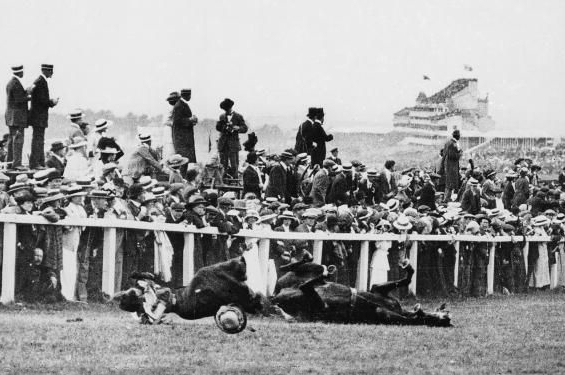The Derby of June 1913
The Epsom Derby of June 1913 saw the death of Emily Wilding Davison - a suffragette who stepped in front of King George’s horse to draw attention to her cause. Davison died from her injuries four days after the race.
The Epsom Derby was, and still is, one of the most prestigious horse race in Britain. In 1913, the event carried a lot of social importance. The Royal family traditionally entered a horse into the race and it was attended by society’s elite.
The horses would race around Tattenham Corner - the last bend before the final straight and winning post, where thousands of spectators would cheer from the stands.

However, on the 4 June 1913 the traditions of the race were disrupted when Emily Davison stepped onto the race course and threw herself at a horse - Anmer, King George’s horse. The jockey fell off the horse after it fell, but. Davison took the full force of a sprinting race horse and was knocked to the ground.
The incident was met with confusion from the crowds. Some thought that Davison may have thought the race was over and had been trying to cross the race course - a tradition that took place at the end of every race.
Other spectators claimed that they heard a woman shout "Votes for Women" before leaping out in front of the king's horse. The incident was caught by British Pathe’s hand-cranked camera. The footage shows Davison stop in front Anmer, suggesting she did not merely want to cross the course. It also shows her try to grab the reigns before she was struck by the horse.
The jockey, Herbert Jones, stayed on the ground until all the riders had rose past. The incident left him with a fractured rib and bruised face, but he made a full recovery. He remembered seeing Davison attempt to take the reigns.
Emily Wilding Davison was very badly injured. She was taken to Epsom Cottage Hospital. She never regained consciousness and she died on 8 June 1913 from substantial internal injuries.
The next day The Morning Post reported the incident under the headline ‘Sensational Derby – suffragist’s mad act’. The ‘sensation’ was not the injuries to Emily; it was the fact that a 100-1 outsider, Aboyeur, had won the race.
Historians now believe that Emily Davison did not intend to kill herself, although the exact purpose of her actions is still not clear. A return train ticket found in her bag suggests that she did not plan to take her own life, but draw attention to her cause.
See also: Women in 1900
MLA Citation/Reference
"The Derby of June 1913". HistoryLearning.com. 2025. Web.
